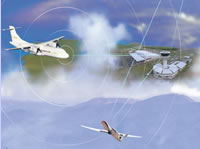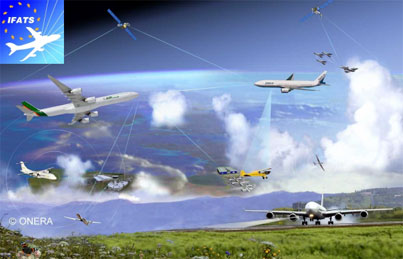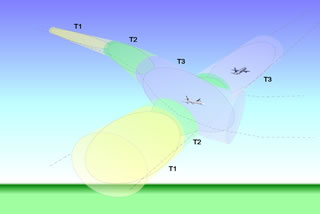
To help define an effective and safe future air transport system, we are thinking about an entirely automatic air transport system...
|
An aircraft without a pilot, a control tower without a controller: a planner's dream, or a passenger's nightmare? Neither, but rather the futurology work of an industrial consortium of researchers and academics coordinated by ONERA who, without wishing to dehumanize everything, are trying to find out what degree of automation is feasible as far as air transport is concerned. The best way of doing this is to imagine a totally automatic air transport system. Airlines would request flights from this centralized system which would calculate the optimal trajectories for all aircraft. |
|
The latter would thus depart following the flight plan, respecting these instructions. And this automatic system would of course be capable of taking into account breakdowns and other problems which will inevitably arise someday.

A central network architecture in which all of the aircraft and all of the ground stations are at the same time both actors and sensors, for the benefit of the entire system.
"Our work consists in imagining what such a system might be like, modelling it and then simulating it", explains Claude Le Tallec, who is in charge of the European IFATS (Innovative Future Air Transport System) project at ONERA. And this, in the long term: 2040. This project was launched in July 2004 and should last for 30 months.
"Travellers have already refused to board an aircraft that did not seem safe to them” says Claude Le Tallec. “Tomorrow, they may refuse to trust the crew. An aircraft without pilots would prevent such refusals". However, it is not certain that travellers feel safer without a crew than with a crew. “Yet,” the researcher points out, “the aircraft "knows" what is happening to it in the event of a problem, while the aircrew will sometimes need some time to figure it out". Thus, at the time of the recent catastrophe which occurred in August 2005 to a Greek-Cypriot airplane belonging to the company Helios, in which the 121 passengers and crew members perished, one of the hypotheses ventured to identify the cause of this accident was that the pilots would not have seen that the pressure valve had been left in the manual mode and they would not have understood the alarms. For Claude Le Tallec, there will necessarily be other catastrophes caused by human error.
"Of course, there have also been situations in which pilots have corrected an unforeseen problem at the time of design of the automatic systems” he points out. But nothing prevents us from integrating their knowledge to future automatic piloting systems, by studying many past situations." The IFATS project does not consist in removing humans from the system. They are not necessarily in the airplane. Man is present on the ground, and if the automatic system does not know how to solve the problem, it will hand back control to a person on the ground. As far as unmanageable breakdowns are concerned, such as a major failure of the aircraft's structure, "The fact that there is a pilot on board or not, does not change things. On the other hand, all situations in which the pilot has the time and the possibility to cope can be handled by automatic systems."
What such an automatic system should be is still to be defined and modelled in order to simulate all of the situations that could possibly occur. "It is not a case of developing automatic systems, but rather just of defining the concept and defining the functions to be fulfilled", explains Claude Le Tallec. And of course, to see if such a system is possible, or if not, to determine the level of automation toward which we can aim. Pilots and controllers are of course reticent regarding this project. What the reaction of future passengers remains to be seen.

Traffic design where the aircraft flies along pre-programmed trajectories called "4D" (space + time) trajectories, with a level of precision and constraints that depends on the traffic density. The 4D trajectory contracts are negotiated between the airplane and the ground segment, they provide flight trajectories free of any conflict.
![L'avion doit rester dans une]()
The aircraft must remain in a "freedom zone" or "free flight zone" evolving in the pre-programmed 4D trajectory, or request a new contract if it can not respect this constraint.
Cécile Michaut, journaliste scientifique.
|







